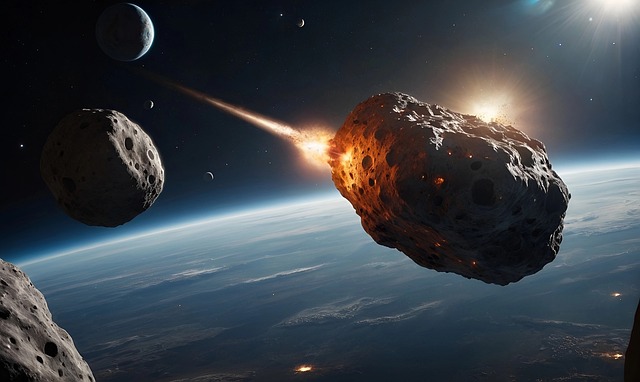Understanding the difference between a meteor and an asteroid can be confusing due to the various terms used to describe space rocks. This article will clarify these terms and explain their unique characteristics, origins, and behaviors.
What is the Difference Between a Meteor and an Asteroid?
What is a Meteor?
Definition and Characteristics: A meteor is a streak of light in the sky produced when a meteoroid (a small fragment of an asteroid or comet) enters Earth’s atmosphere and burns up. Meteors are often referred to as “shooting stars,” though they are not stars at all. They can vary in brightness, with particularly bright meteors known as fireballs.
Meteoroids and Meteorites:
- Meteoroids: These are small rocky or metallic bodies in space, significantly smaller than asteroids. They range from tiny grains of dust to objects up to a meter in diameter.
- Meteorites: If a meteoroid survives its passage through the atmosphere and lands on Earth’s surface, it is called a meteorite. Meteorites provide valuable information about the composition of other celestial bodies.
Formation and Source: Meteors originate from meteoroids, which in turn can come from comets or asteroids. When comets pass close to the sun, they shed material that can later enter Earth’s atmosphere as meteors. Similarly, collisions between asteroids can create debris that becomes meteoroids.
What is an Asteroid?
Definition and Characteristics: Asteroids are small rocky bodies that orbit the sun, primarily found in the asteroid belt between Mars and Jupiter. They vary in size from tiny pebbles to objects that are hundreds of kilometers in diameter. Unlike planets, asteroids do not have an atmosphere.
Formation and Composition: Asteroids are remnants from the early solar system, over 4.6 billion years old. They are composed mostly of rock and metal, with some containing clay and silicate rocks. The diversity in composition among asteroids is due to the different conditions under which they formed. Some asteroids, like Ceres, are large enough to have been shaped into spheres by their gravity.
Location: Most asteroids are found in the asteroid belt, a region filled with these rocky bodies that never coalesced into a planet due to Jupiter’s gravitational influence. Some asteroids, however, have orbits that bring them closer to Earth, known as Near-Earth Objects (NEOs).
Key Differences Between Meteors and Asteroids
- Size and Composition:
- Asteroids: Larger and composed of rock and metal, some of which have enough gravity to become spherical.
- Meteors: Smaller, often fragments of asteroids or comets, visible as streaks of light when they burn up in the atmosphere.
- Location:
- Asteroids: Primarily found in the asteroid belt between Mars and Jupiter, though some have orbits near Earth.
- Meteors: Not located in a specific region of space but occur when meteoroids enter Earth’s atmosphere.
- Observation:
- Asteroids: Observed with telescopes as they orbit the sun.
- Meteors: Seen as bright streaks of light in the night sky when they enter Earth’s atmosphere.
The Importance of Studying Meteors and Asteroids
Scientific Significance: Studying asteroids helps scientists understand the early solar system, as these bodies are relatively unchanged remnants from that era. Analyzing meteorites provides insights into the composition of asteroids and comets, offering clues about the formation of planets and other celestial bodies.
Hazard Assessment: Asteroids, especially NEOs, are monitored for potential collision with Earth. Understanding their orbits and characteristics is crucial for planetary defense strategies. Meteors, on the other hand, while less of a threat due to their smaller size, can still cause significant damage if they are large enough to survive their descent to the surface.
Conclusion
In summary, asteroids are large, rocky bodies that orbit the sun, mostly found in the asteroid belt, while meteors are the visible streaks of light produced when smaller meteoroids enter Earth’s atmosphere and burn up. Understanding the differences between these celestial objects is essential for both scientific research and planetary defense. By studying these space rocks, scientists can gain valuable insights into the history and dynamics of our solar system.
For more detailed information, you can refer to resources like Live Science and Science Notes (livescience.com) (Science Notes and Projects).
For more information like this stay connect with us on latestbite.com

